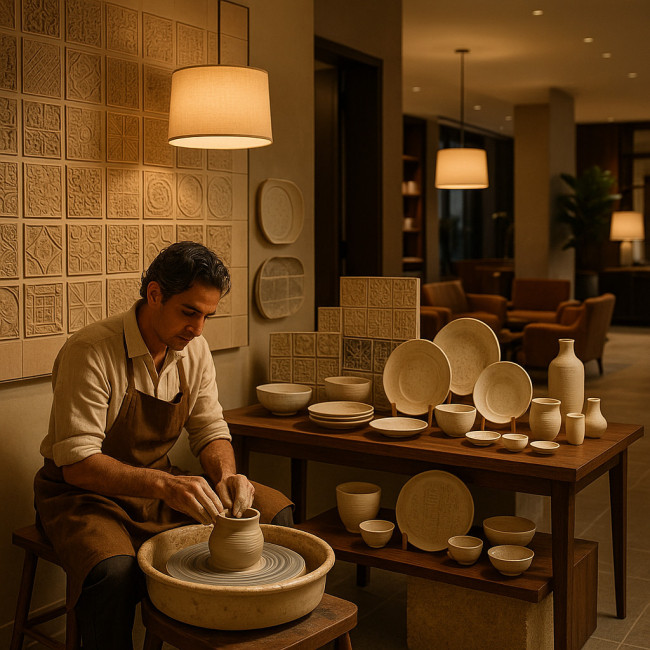Sourcing local ceramists for hotel refurbishments: procurement roadmap
Looking to refresh guest rooms, lobbies or restaurants with distinctive, durable ceramics? This roadmap walks you through every procurement step — from pre-brief to post-install — so you can source local ceramists efficiently, stay on budget and delight travellers with authentic craftsmanship.
Why prioritise local ceramists in hotel projects?

Local makers offer shorter lead times, lower freight risk and a story guests remember. When you source local ceramists, you also reduce transport emissions and keep spend within the community, two advantages increasingly valued by both investors and travellers. Moreover, hotel staff can coordinate guest workshops at the studios, turning craft discovery into an ancillary revenue stream while deepening the property's sense of place. These interactive moments foster memorable narratives that guests share online, amplifying word-of-mouth marketing without paid media. The human connection forged when travellers meet the artisan who crafted their breakfast plate translates into higher satisfaction scores, stronger brand loyalty and an uptick in repeat bookings across the portfolio.
Guest-experience impact
- Hand-thrown tableware elevates farm-to-table dining.
- Site-specific lobby sculptures become Instagram magnets.
- Bathroom accent tiles boost perceived room value by up to 12 %* in post-stay surveys.
Sustainability & brand alignment
Hotels committed to net-zero goals can use local sourcing to cut freight emissions by 60–80 % compared with overseas shipments, while storytelling assets about local craft deepen brand identity.
Procurement roadmap in six actionable phases
1. Define scope and performance criteria
Start with a clear specification sheet: quantities, functional requirements (food-safe glazes, slip resistance, dishwasher cycles), aesthetic keywords and budget parameters. Use glaze-durability briefs as a template to speed alignment between design, F&B and procurement teams.
2. Build a long-list of makers
Leverage directories to identify studios within a 200 km radius. To see real-time portfolios and credentials, discover vetted local ceramists on Artfolio. Look for:
- Studio capacity metrics — use this capacity assessment guide to match order size and timeline.
- Sustainability labels — check verified eco-labels to support CSR reporting.
- Insurance coverage for on-site installation if you commission large pieces.
3. Issue a concise request for proposal (RFP)
Your RFP should be limited to two pages and cover:
- Design intent & inspiration images.
- Technical performance criteria.
- Volume brackets (pilot, roll-out, spares).
- Desired delivery milestones with buffers.
- Evaluation matrix (price 40 %, quality 30 %, sustainability 20 %, storytelling 10 %).
Attach NDAs if proprietary patterns are involved. For one-off decorative pieces, consider exclusive rights under limited-edition clauses.
4. Evaluate samples and prototypes
Ask shortlisted ceramists to submit either physical samples or a remote glazing approval video. Score against:
- Color accuracy under hotel lighting temperatures (2700–3000 K).
- Impact resistance — minimum 0.9 J for tableware, 1.5 J for floor tiles.
- Ease of cleaning: aim for water absorption < 0.5 %.
5. Contract & production oversight
Negotiate milestone payments: 30 % on contract, 40 % after first kiln firing, 30 % on delivery. Embed penalties for missed milestones but offer incentives for early completion. Weekly progress photos or short clips keep stakeholders aligned without site visits.
6. Delivery, installation and after-care
Coordinate white-glove delivery with studios experienced in fragile shipments. Specify crate drop zones nearest elevators to reduce handling. Post-install, supply a care manual covering cleaning agents, replacement lead times and contact details for re-orders.
Cost & lead-time benchmark
| Item | Local Ceramist | Overseas Supplier |
|---|---|---|
| Custom dinner plate | €18–22 | €14–17 |
| Accent wall tile (m2) | €75–90 | €60–70 |
| Lobby sculpture (1 m) | €2 800–3 500 | €2 400–3 200 |
| Average lead time | 6–8 weeks | 12–16 weeks |
| Freight damage risk | < 2 % | 8–10 % |
*Data compiled from 12 European hotel refurbishments completed in 2023–2024.
Source : Hotel Market Report 2024
Common pitfalls and how to avoid them
- Underestimating spare ratios — order 7 % extra for breakage and future repairs.
- Ignoring kiln schedules — peak tourist seasons strain studio capacity.
- Skipping insurance checks — confirm transit and installation coverage to prevent liability gaps.
Interactive checkpoint: Are you procurement-ready?
FAQ
- How early should we involve a local ceramist in the refurbishment timeline?
- Ideally 10–12 months before the opening date. This allows for design iterations, sample testing and contingency buffers.
- Can local studios handle chain-wide roll-outs?
- Yes, many scale via satellite kilns or subcontractors. Review their capacity reports and demand guaranteed batch consistency tests.
- What if a piece breaks mid-season?
- Stipulate a hot-swap stock held at the studio and rapid-ship terms (<48 h domestic) inside the maintenance clause.
- Are there tax incentives for regional sourcing?
- Several regions offer craft preservation grants and VAT reductions on artwork; consult local chambers of commerce early.
Next step: turn knowledge into impact
Ready to brief a maker? Download our editable RFP template and schedule a discovery call with your top three studios this week. By applying the roadmap above, you'll secure distinctive ceramics, control timelines and create spaces guests talk about long after checkout.
Act now — your ideal ceramist's kiln slots fill fast.